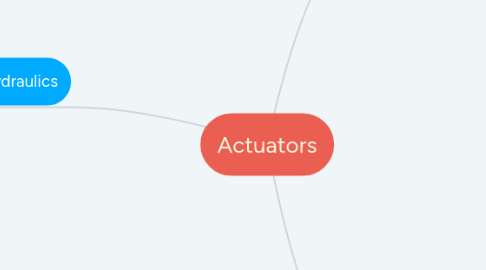
1. 3.- Hydraulics
1.1. Types:
1.1.1. Hydraulic cylinder:
1.1.1.1. Simple effect:
1.1.1.1.1. Hydraulic force is used to push and a different external force to contract.
1.1.1.2. Action or double effect:
1.1.1.2.1. Hydraulic force is used to perform both actions.
1.1.2. Hydraulic engine:
1.1.2.1. The rotary motion is generated by pressure.
1.1.3. Oscillation hydraulic motor:
1.1.3.1. Absorb a certain volume of fluid under pressure and return it to the circuit when it needs it.
1.2. Functioning:
1.2.1. Transmit movement to parts or elements, previous orders given by the control and command unit.
1.2.2. They use mineral oils as energy, which work at pressure between 50 and 100 bars and which can sometimes exceed 300 bars.
1.3. Characteristics:
1.3.1. · They are the elements in charge of driving the hydraulic oil or liquid, transforming the rotating mechanical energy into hydraulic energy.
1.4. Comunication way:
1.4.1. · They are used when what is needed is power, and the tires are simple positioning.
1.4.2. They require too much equipment for power supply, as well as periodic maintenance.
1.4.3. The applications of the pneumatic models are also limited from the point of view of precision and maintenance.
2. 1.- Electrical
2.1. Types:
2.1.1. Direct current motors (DC) :
2.1.1.1. Consisting of two internal windings, inductor and armature.
2.1.2. Alternating current motors (AC):
2.1.2.1. · Synchronous. · Asynchronous.
2.1.3. Stepper motors:
2.1.3.1. · Of permanent magnets. · Variable reluctance. · Hybrids.
2.2. Functioning:
2.2.1. Electric cables are used to transmit electricity and signals.
2.2.2. It is highly versatile and there are virtually no restrictions on the distance between the power source and the actuator.
2.2.3. There are a large number of models and it is easy to use them with standardized electric motors depending on the application.
2.2.4. In most cases it is necessary to use reducers, since the motors are continuously operated.
2.3. Characteristics:
2.3.1. Control, simplicity and precision of electric drives have made them the most used in today's industrial robots
2.4. Comunication way:
2.4.1. Electric actuators communicate through their operation, since if a part fails, the action required to carry out its movement cannot be performed.
3. 2.- Mechanics
3.1. Types:
3.1.1. Hydraulics:
3.1.1.1. They are those that are transmitted through liquids when they are pressed.
3.1.2. Tires:
3.1.2.1. They are those that work by the force of compressed air.
3.2. Functioning:
3.2.1. It allows the "total" or partial elimination of human intervention.
3.3. Characteristics:
3.3.1. · High reliability, simplicity of use. · Minimum maintenance · Security and positioning precision
3.3.2. · Data entry or orders. · Data control. · Carrying out specific tasks.
3.4. Comunication way:
3.4.1. When we apply a force on a certain surface we say that we exert pressure.
3.4.2. The larger the surface on which we apply the force, the smaller the pressure we exert on it.
3.4.3. The smaller the surface, the greater the pressure.
